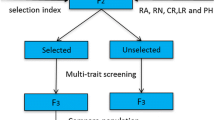Abstract
The most important breeding objectives in crop improvement are improving grain yield, grain quality, and resistances to various biotic and abiotic stresses. The objectives of our study were to compare two crossing and four selection schemes for grain yield, yield traits, and slow rusting resistance to leaf rust (Puccinia recondita) based on additive genes in wheat (Triticum aestivum), and to identify the most efficient crossing and selection methodologies in terms of genetic gains and cost efficiency. Segregating populations were derived from 18 simple crosses and the same number of top (three-way) crosses. Half of the crosses were derived from Yecora 70 and the other half from Veery #10 as the common leaf rust susceptible parents. The four selection schemes were: pedigree, modified bulk (F2 and F1-top as pedigree, selected lines in F3, F4, F2-top, F3-top as bulk; and pedigree in F5 and F4-top populations), selected bulk (selected plants in F2, F3, F4, F1-top, F2-top and F3-top as bulk; and pedigree in F5 and F4-top populations), and nonselected bulk (bulk in F2, F3, F4, F1-top, F2-top and F3-top; and pedigree in F5 and F4-top populations). A total of 320 progeny lines, parents and checks were tested for grain yield, other agronomic traits and leaf rust resistance during the 1992/93 and 1993/94 seasons in Ciudad Obregon (Sonora State, Mexico) which represents a typical high yielding irrigated site. The influence of the type of cross and the selection scheme on the mean grain yield and other traits of the progenies was minimal. The selection of parents was the most important feature in imparting yield potential and other favourable agronomic traits. Moreover, the highest yielding lines were distributed equally. Progeny lines derived from Veery #10 crosses had significantly higher mean grain yield compared to those derived from the Yecora 70 crosses. Furthermore, a large proportion of the highest yielding lines also originated from Veery #10 crosses. Mean leaf rust severity of the top cross progenies was lower than that of the simple cross progenies possibly because two parents contributed resistance to top cross progenies. Mean leaf rust severity of the nonselected bulk derivatives was twice that of lines derived from the other three schemes. Selected bulk appears to be the most attractive selection scheme in terms of genetic gains and cost efficiency.
Similar content being viewed by others
References
Allard, R.W., 1960. Principles of Plant Breeding. John Wiley & Sons, Inc., New York and London. 484 pp.
Bjarko, M.E. & R.F. Line, 1988. Quantitative determination of the gene action to leaf rust resistance in four cultivars of wheat, Triticum aestivum. Phytopathology 78: 451–456.
Broers, L.H.M. & T. Jacobs, 1989. The inheritance of host plant effect on latency period of wheat leaf rust in spring wheat. II. Number of segregating factors and evidence for transgressive segregations in F3 and F5 generations. Euphytica 44: 207–214.
Ma., H. & R.P. Singh, 1996. Contribution of adult plant resistance gene Yr18 in protecting wheat from yellow rust. Plant Dis 80 (1): 66–69.
Kuhn, R.C., H.W. Ohm & G. Shaner, 1980. Inheritance of slow leaf-rusting resistance in Suwon 85 wheat. Crop Sci 20:665–659.
Peterson, R.F., A.B. Campbell & A.E. Hannah, 1948. A diagrammatic scale for estimating rust severity on leaves and stems of cereals. Can J Res C 26: 496–500.
Singh, R.P., 1991. Pathogenicity variations of Puccinia recondita f. sp. tritici and P. graminis f. sp. tritici in wheat-growing areas of Mexico during 1988 and 1989. Plant Dis 75(8): 790–794.
Singh, R.P. & S. Rajaram, 1992. Genetics of adult-plant resistance to leaf rust in Frontana and three CIMMYT wheats. Genome 35: 24–31.
Singh, R.P. & S. Rajaram, 1995. Genetic basis of durable resistance to leaf rust and stripe rust in CIMMYT wheat germplasm and CIMMYT's current resistance breeding strategies. In Z.S. Li & Z.Y. Xin (Eds.), Proceedings of the 8th International Wheat Genetics Symposium, pp.901–905. China Agricultural Scientech Press, Beijing.
Author information
Authors and Affiliations
Rights and permissions
About this article
Cite this article
Singh, R., Rajaram, S., Miranda, A. et al. Comparison of two crossing and four selection schemes for yield, yield traits, and slow rusting resistance to leaf rust in wheat. Euphytica 100, 35–43 (1998). https://doi.org/10.1023/A:1018391519757
Issue Date:
DOI: https://doi.org/10.1023/A:1018391519757



